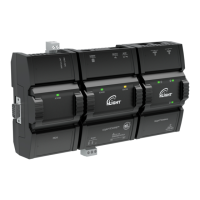Data Bus Physical Specifications and Cable Requirements
Cables composed of stranded conductors are preferred over solid conductors as stranded conductor cable better resist
breakage during pulling operations. It is strongly recommended that the following data bus segment cable specifications be
respected.
Parameter Details
Media Twisted pair, 24 AWG
Shielding Foil or braided shield
Shield grounding
The shield on each segment is connected to the electrical system ground at one
point only; see Data Bus Shield Grounding Requirements.
Characteristic impedance 100-130 Ohms. The ideal is 100-120 Ohms.
Distributed capacitance between conductors
Less than 100 pF per meter (30 pF per foot). The ideal is less than 60 pF per meter
(18 pF per foot).
Distributed capacitance between conductors and shield Less than 200 pF per meter (60 pF per foot)
Maximum length per segment 1220 meters (4000 feet)
Data Rate 9600, 19 200, 38 400, and 76 800 baud
Polarity Polarity sensitive
Multi-drop Daisy-chain (no T-connections)
EOL terminations 120 ohms at each end of each segment
Data bus bias resistors 510 ohms per wire (max. of two sets per segment)
Table6: BACnet MS/TP Data Bus Segment Physical Specifications and Cable Requirements
Shielded cable offers better overall electrical noise immunity than non-shielded cable. Unshielded cable or cable of a differ-
ent gauge may provide acceptable performance for shorter data bus segments in environments with low ambient noise.
Cable Type O.D. (Ø)
300 meters (1000 feet), 24 AWG Stranded, Twisted Pair Shielded Cable – FT6, Rated for Plenum Applications 3.75mm (0.148 in.)
Table7: Recommended Cable Types for BACnet MS/TP Data Buses
Data Bus Topology and EOL Terminations
Function of EOL Terminations
The first and last device on the data bus must have End-of-Line (EOL) termination resistors connected across the two data
lines/wires of the twisted pair. These resistors serve the following purposes:
£ EOL terminations dampen reflections on the data bus that result from fast-switching (high-speed rising and falling data
edges) that otherwise would cause multiple data edges to be seen on the data bus with the ensuing data corruption
that may result. The higher the baud rate a data bus is operating at, the more important that EOL terminations be prop-
erly implemented. Electrically, EOL terminations dampen reflections by matching the impedance to that of a typical
twisted pair cable.
£ EIA-485 data bus transmitters are tri-state devices. That is they can electrically transmit 1, 0, and an idle state. When
the transmitter is in the idle state, it is effectively off-line or disconnected from the data bus. EOL terminations serve to
bias (pull-down and pull-up) each data line/wire when the lines are not being driven by any device. When an un-driven
data bus is properly biased by the EOL terminations to known voltages, this provides increased noise immunity on the
data bus by reducing the likelihood that induced electrical noise on the data bus is interpreted as actual data.
BACnet MS/TP Communication Data Bus Fundamentals
94
nLight ECLYPSE

